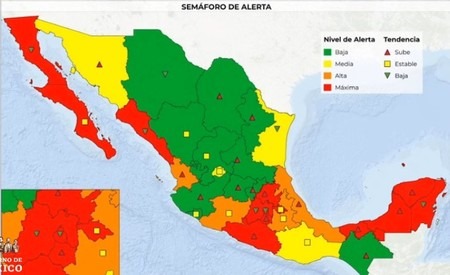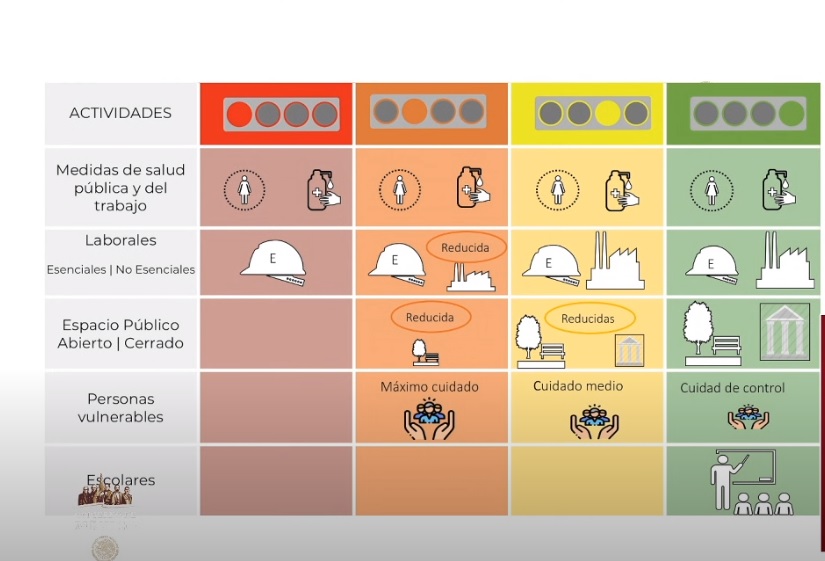At the May 13th daily morning press briefing of Mexican President Andrés Manuel López Obrador (AMLO), details were provided as to how the country intends to gradually start reopening productive, social, cultural, and economic activities across the country.
On April 16th, the Federal government had originally extended nationwide restrictions on non-essential activities until the end of May, in response to the Covid-19 pandemic. In sync with that timeline, today’s national press briefing detailed 3 Phases the federal government is going by as the country returns to the “Nueva Normalidad” (New Normal).
Phase 1. May 18th – “Municipios de la Esperanza” (Municipalities of Hope) In 269 municipalities across 15 Mexico states where there are no reports of coronavirus cases, economic and social activities will start to resume fully, under strict health protocols. (This does not pertain to Puerto Peñasco) In addition, from May 14 – 17, health barriers will be set up around these municipalities to restrict access or contagion. These steps are only for municipalities where there are no reported cases of coronavirus, nor are there neighboring municipalities with cases
Phase 2. May 18th – May 31st Preparation phase across country prior to resuming activities in the New Normal. During this time, construction, mining, and vehicle manufacturing can resume, under strict health protocols, as they are considered to move into the essential category.
Phase 3. June 1st – End of “Sana Distancia” (Healthy Distancing) campaign and implementation of nationwide “Stoplight” as to how to proceed per region in resuming social, cultural, economic, and productive activities. Following this date there will be continual updates on the status of regions across the country.
Regional Covid-19 Stoplight in resuming activities in Mexico

Red – Only essential activities, expanded solely to construction, mining, and vehicle manufacturing. Maximum care/stay at home for vulnerable individuals (those with chronic illnesses and older individuals)
Orange – In addition to the above, activities not deemed essential but at a reduced level, reopening of public spaces at a reduced level (outdoor), and ongoing attention for vulnerable individuals (those with chronic illnesses and older individuals) in returning to workforce as appropriate
Yellow – In addition to the above, resuming all essential / non-essential businesses, opening of public spaces (outdoor), and opening of indoor public spaces at reduced capacity (museums, churches, movie theaters), ongoing attention to vulnerable populations though they also may return to workforce
Green – That listed above, as well as resuming of educational sector with children and teachers in schools (per school year calendar)

On the “Alert Level and Trends Map”, each state is indicated in one of the above colors – along with an inner arrow (red or green) or a yellow box specifying if the current trend in coronavirus cases in that state is on the rise (as in the case of Sonora), the decline (as in Oaxaca), or maintaining (as in Baja California Sur). This map is to be updated periodically.
Specific protocols for industries across Mexico are still being developed, including tourism. Detailed protocols have yet to be defined for hotels, air travel, tours, and other aspects that would impact tourist destinations.
The May 12th Health Alert Advisory issued by the U.S. Embassy in Mexico City indicated, “The number of confirmed and suspected cases is still increasing daily in several regions of Mexico. Mexico City, Tabasco, Morelos, Yucatan, and Quintana Roo currently report the highest incident rate of active cases (incident rate is the number of cases per 100,000 inhabitants in the last 14 days). Hospital occupancy rates are also increasing, with the highest levels in Mexico City, Baja California, Mexico State, and Sinaloa.”
As of May 12th, Sonora Secretary of Health Enrique Clausen reported there have been 686 cases of Covid-19 in the state since March 16th, and 55 deaths. Puerto Peñasco has had 2 confirmed cases of coronavirus.